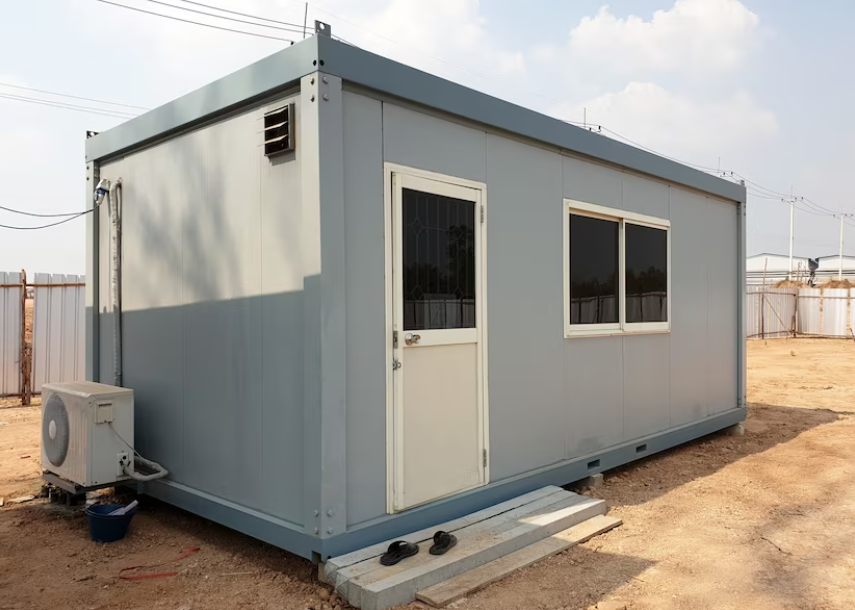Email: info@yimuhouse.com Whatsapp: (+86)13391718082

Get A Quote
How to Power a Shipping Container? A Comprehensive Guide
In this blog, we'll explore the step-by-step process of wiring a shipping container home, common uses for adding electrical features, materials preparation, power options, and essential defense measures against lightning. Join us on this electrifying journey, where we shed light on turning shipping containers into cozy living spaces.
Tips for Wiring a Shipping Container Home
Wiring a shipping container home demands a systematic approach, ensuring safety and functionality. Here's a breakdown of the key points to consider:
- Strategic Planning: Begin by meticulously planning the electrical layout. Identify optimal locations for outlets, switches, and lighting fixtures to ensure a well-lit and convenient living space.
- Load Analysis: Determine your power needs by conducting a thorough load analysis. This step is critical for selecting an appropriately sized electrical service panel, preventing future overloads.
- Weatherproofing Materials: Given the harsh conditions containers endure, prioritize weather-resistant materials. Opt for corrosion-resistant conduit and weatherproof electrical boxes to protect your wiring from external elements.
- Safety Standards Compliance: Ensure all materials used comply with safety standards. This includes using fire-resistant and insulating materials to prevent electrical hazards and ensure the longevity of your installation.
- Customization: Container living allows for unique layouts. Leverage this by customizing the wiring plan to suit your specific needs, whether it's a cozy living space or a fully equipped workspace.
- Professional Assistance: While DIY projects are rewarding, seeking professional assistance, especially for intricate wiring tasks, can provide expertise and peace of mind. A licensed electrician can guide you through the process and ensure compliance with local regulations. Taking a methodical approach to wiring your shipping container home not only guarantees a safe and functional space but also allows for a seamless integration of modern conveniences.
Common Uses for Adding Electrical Features
Shipping containers can be transformed into versatile living spaces, and adding electrical features opens up a world of possibilities. Common Uses for Adding Electrical Features:
1. Lighting:
- Crucial for all types of containers, even those used solely for storage.
- Especially essential during darker winter months for improved visibility.
2. Heating:
- Vital for office container conversions to ensure habitability during winter.
- Consideration for investing in an air conditioning unit for summer comfort.
3. Power Sockets:
- Basic requirement across diverse conversion types (offices, workshops, cafes, etc.).
- Necessary for powering tools, equipment, computers, and everyday appliances.
- Essential for a functional workspace, including the vital coffee kettle.
4. Food Preparation:
- Crucial for containers transformed into catering units.
- Requires a comprehensive electrical setup to power ovens, extractor fans, and water heaters.
5. Internet:
- Integral for contemporary offices.
- A reliable power supply ensures seamless internet connectivity.
- Completes the modern workspace, catering to digital demands.
Preparing Materials for Adding Electrical Features
Before diving into the electrical work, proper preparation of materials is essential. This includes selecting durable wiring, electrical panels, and outlets suitable for container living. Corrosion-resistant materials are crucial due to the potential exposure to varying weather conditions. As part of the preparation, ensure you have a reliable source of power. Consider renewable energy sources such as solar panels, a popular choice for sustainable container homes. This not only reduces the environmental impact but also offers long-term cost savings.
How to Power a Shipping Container?
Powering a shipping container efficiently involves careful consideration of various factors to ensure a reliable and sustainable energy source. Here's a detailed breakdown:
1. Solar Power:
- Consider harnessing solar energy for an eco-friendly and off-grid solution.
- Solar panels can be mounted on the container's roof, providing a continuous power source.
- Ideal for sustainable living, offering long-term cost savings and minimal environmental impact.
2. Local Power Grid Connection:
- In urban areas, connecting to the local power grid is a practical option.
- Ensures a constant and reliable power supply, suitable for traditional energy needs.
- Provides convenience and stability, especially for locations with established infrastructure.
3. Hybrid Systems:
- Combine solar power with a connection to the local power grid for a versatile and reliable setup.
- Offers flexibility, allowing you to switch between power sources based on availability and need.
- Ensures redundancy, minimizing the risk of power outages and disruptions.
4. Battery Storage:
- Integrate battery storage systems to store excess energy generated, ensuring a continuous power supply during periods of low sunlight.
- Enhances the sustainability of solar-powered containers by providing stored energy for nighttime or cloudy days.
5. Generator Backup:
- Consider including a generator as a backup power source for additional reliability.
- Ideal for situations where solar energy may not be sufficient, providing a dependable alternative.
Shipping Container Lightning Defense Measures
Ensuring the safety of your shipping container home includes implementing lightning defense measures. Lightning strikes can pose a threat, but proper precautions can minimize the risk. Install lightning rods on the container's roof to divert electrical currents safely to the ground. Additionally, invest in surge protectors to safeguard electronic devices from power surges caused by lightning.
Conclusion
Transforming a shipping container into a functional home with electricity is an exciting journey that requires careful planning and execution. Whether you're considering a tiny home, a remote office, or a sustainable living space, the right wiring and power solutions are key to a successful project. By following our comprehensive guide and considering the insights from Yimuhouse, you can embark on this electrifying adventure with confidence. Create a space that not only meets your electrical needs but also reflects your commitment to sustainable living.

